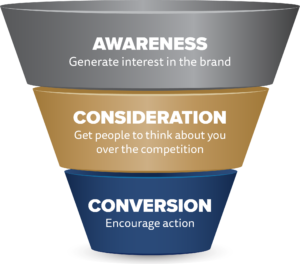
The Basics of Full-Funnel Marketing
What is a marketing funnel? The marketing funnel is a way to visualize the process of turning leads into customers. Imagine a classic funnel shape. A full-funnel marketing approach begins at the top of the funnel by casting a wide net to capture as many leads as possible. As you move down the funnel, it becomes narrower and the efforts of your marketing become more focused, targeting the most qualified audience with the highest propensity to convert.

What are the stages of the marketing funnel? Funnel stages can vary based on industry, marketing approach, etc. However, we at Innovative use the following three stages:
- Awareness—generate awareness and education to influence consideration among new audiences who may not be familiar with your brand.
- Consideration—get people to think about your brand over the competition.
- Conversion—encourage action whether it’s an online sale, landing page form completion, or another action.
What is a full-funnel marketing approach? A full-funnel marketing approach reaches potential consumers based on where they fall within the funnel. Because customers require a different approach at every stage of the funnel (and therefore different messaging, creative, etc.) it’s important to adjust marketing strategies accordingly. This strategic approach also carries over to the marketing tactics you use for your campaign, as each tactic has a different objective and goal.
For example:
- Awareness—tactics like online display, pre-roll video and content marketing are great for generating awareness and keeping brands top of mind.
- Consideration—tactics like paid search, email marketing and social advertising help to reinforce a particular brand while also ensuring brand visibility and discoverability as potential consumers are searching for your brand’s product or services.
- Conversion—tactics like retargeting aid in reinforcing and encouraging action.
It’s also important to remember that campaigns targeting these distinct stages have different objectives and therefore must be measured using different metrics.
For example:
- Awareness—impressions and reach
- Consideration—clicks to website and click-through rate
- Conversion—total conversions, cost per conversion and return on investment
This process may seem linear, but it’s actually a full circle. Once you’ve completed a round of monitored full-funnel marketing, take time to analyze and measure the impact, evaluate the experience and launch your next marketing effort.

Nicole Wetwiski, Director of Digital Marketing
Innovative Advertising is a full-service marketing firm and digital advertising agency located on the Northshore of New Orleans. We partner with B2C, B2B, and non-profits to create completely original design, digital, advertising, public relations, and media solutions. Following a disciplined approach, our team conducts analyses and optimizations of these cross-platform brand development efforts to create sound marketing solutions with demonstrable results.